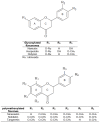Free and Bound Phenolic Compounds Present in Orange Juice By-Product Powder and Their Contribution to Antioxidant Activity
- PMID: 36139822
- PMCID: PMC9495309
- DOI: 10.3390/antiox11091748
Free and Bound Phenolic Compounds Present in Orange Juice By-Product Powder and Their Contribution to Antioxidant Activity
Abstract
Interest in fruit/vegetable consumption is not always linked to a particular diet but rather derives from their high antioxidant activity (AOA), with potential health benefits provided, in part, by polyphenols. Although phenols can be found in free form (FP) or bound to plant tissues (BP), the experimental methodology most frequently used for the quantification of total phenols (TP) is based on the extraction of a portion of FP, which may justify the lack of correlation often found between them and AOA. In this context, four successive extractions were performed to obtain FP and BP of powdered orange juice by-product, and their contribution to the AOA was studied. The first extract (MeOH, 30 °C) can be assumed to be one of the conventional methods for the quantification of TP. Re-extraction with MeOH (60 °C) afforded the FP. Two subsequent basic and acidic extractions yielded the BP. Although the FPs were the most abundant, the AOA (DPPH method) of the last fraction of BP was of the same order found in the first fraction of FP. This highlights the interest in extracting the BP from the by-product of orange juice if its antioxidant capacity is to be exploited.
Keywords: antioxidant activity; bound phenols; free phenols; orange juice by-product.
Conflict of interest statement
The authors declare no conflict of interest. The funders had no role in the design of the study; in the collection, analyses, or interpretation of data; in the writing of the manuscript; or in the decision to publish the results.
Figures





References
-
- Afam I.O.J., Henry S., Thakhani T., Adewale O.O., Henry O.U., Tonna A.A. Antioxidant-rich natural fruit and vegetable products and human health. Int. J. Food Prop. 2021;24:41–67. doi: 10.1080/10942912.2020.1866597. - DOI
-
- Arturo-Calvache J.E., Ramírez-Delgadillo C.J. Ph.D. Thesis. Fundación Universidad de América; Bogota, Columbia: 2020. Evaluación de la Extracción de Flavonoides a Partir de la Cáscara de la Naranja.
-
- Asqui-Quishpe M.A., Cortez Pérez A.A. Ph.D. Thesis. Universidad de Guayaquil; Guayaquil, Ecuador: 2022. Efectos de la Liofilización en la Actividad Antioxidante del Arazá (Eugenia Stipitata Mcvaugh)
Grants and funding
LinkOut - more resources
Full Text Sources
Miscellaneous

